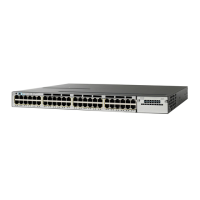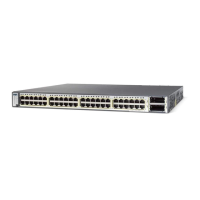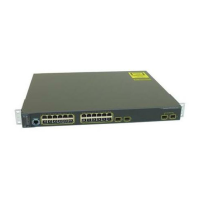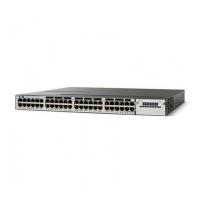2-59
Catalyst 3750-X and 3560-X Switch Command Reference
OL-29704-01
Chapter 2 Catalyst 3750-X and 3560-X Switch Cisco IOS Commands
auto qos trust
Command Modes Interface configuration
Command History
Usage Guidelines Use this command to configure the QoS for trusted interfaces within the QoS domain. The QoS domain
includes the switch, the network interior, and edge devices that can classify incoming traffic for QoS.
Auto-QoS configures the switch for connectivity with a trusted interface. The QoS labels of incoming
packets are trusted. For nonrouted ports, the CoS value of the incoming packets is trusted. For routed
ports, the DSCP value of the incoming packet is trusted.
To take advantage of the auto-QoS defaults, you should enable auto-QoS before you configure other QoS
commands. You can fine-tune the auto-QoS configuration after you enable auto-QoS.
If the port is configured with auto-QoS trust, it trusts all the packets on the port. If the packets are not
marked with a DSCP or CoS value, default marking takes affect.
Note The switch applies the auto-QoS-generated commands as if the commands were entered from the
command-line interface (CLI). An existing user configuration can cause the application of the generated
commands to fail or to be overridden by the generated commands. These actions occur without warning.
If all the generated commands are successfully applied, any user-entered configuration that was not
overridden remains in the running configuration. Any user-entered configuration that was overridden can
be retrieved by reloading the switch without saving the current configuration to memory. If the generated
commands fail to be applied, the previous running configuration is restored.
After auto-QoS is enabled, do not modify a policy map or aggregate policer that includes AutoQoS in its
name. If you need to modify the policy map or aggregate policer, make a copy of it, and change the
copied policy map or policer. To use the new policy map instead of the generated one, remove the
generated policy map from the interface, and apply the new policy map.
To display the QoS configuration that is automatically generated when auto-QoS is enabled, enable
debugging before you enable auto-QoS. Use the debug auto qos privileged EXEC command to enable
auto-QoS debugging. For more information, see the debug auto qos command.
Table 2-5 Auto-QoS Configuration for the Egress Queues
Egress Queue Queue Number CoS-to-Queue Map
Queue Weight
(Bandwidth)
Queue (Buffer) Size
for Gigabit-Capable
Ports
Queue (Buffer)
Size for 10/100
Ethernet Ports
Priority (shaped) 1 4, 5 up to 100 percent 25 percent 15 percent
SRR shared 2 2, 3, 6,7 10 percent 25 percent 25 percent
SRR shared 3 0 60 percent 25 percent 40 percent
SRR shared 4 1 20 percent 25 percent 20 percent
Release Modification
12.2(55)SE This command was introduced.

